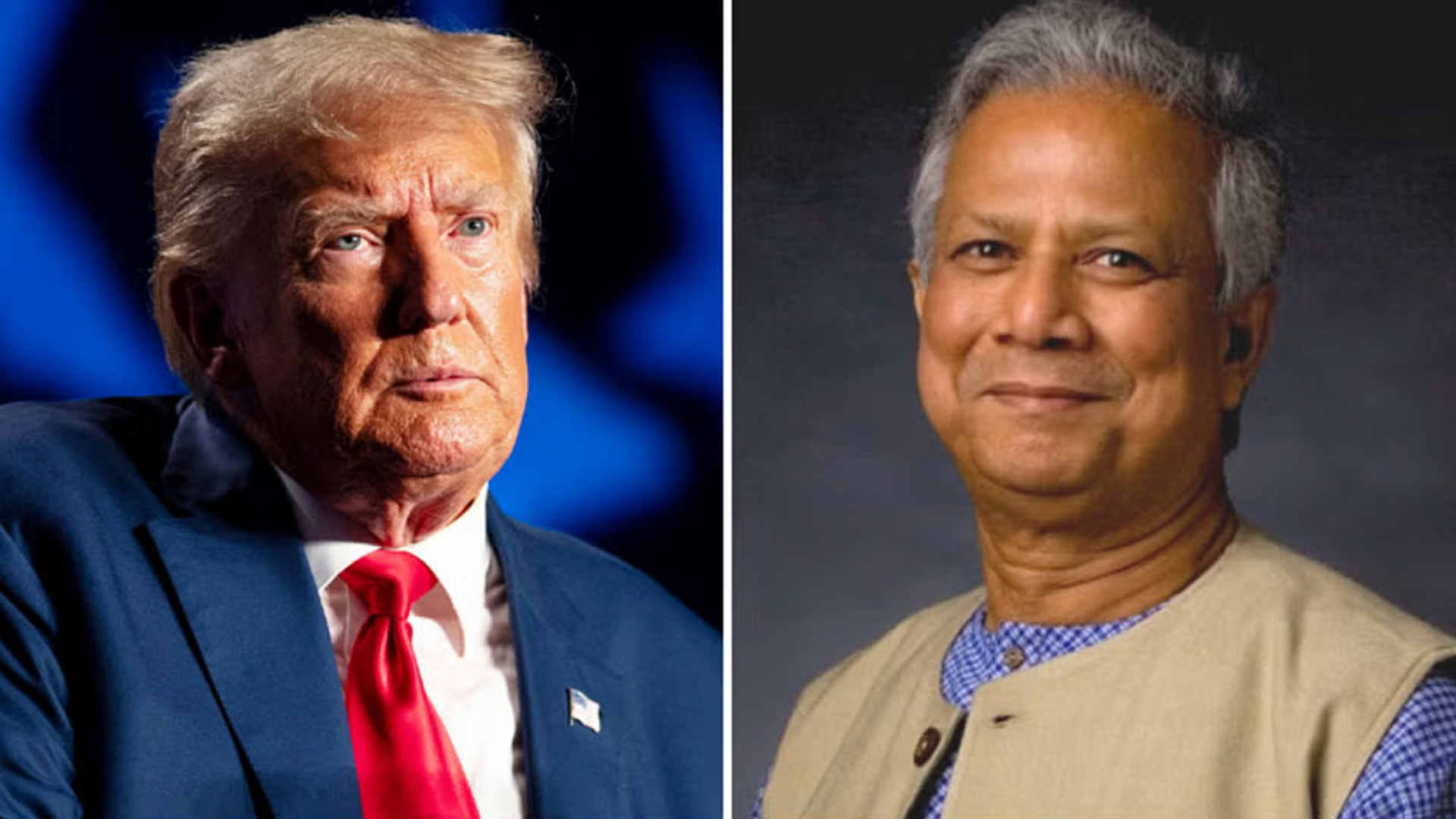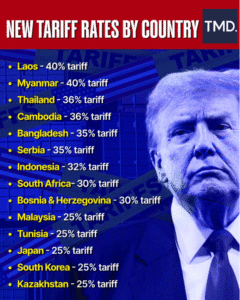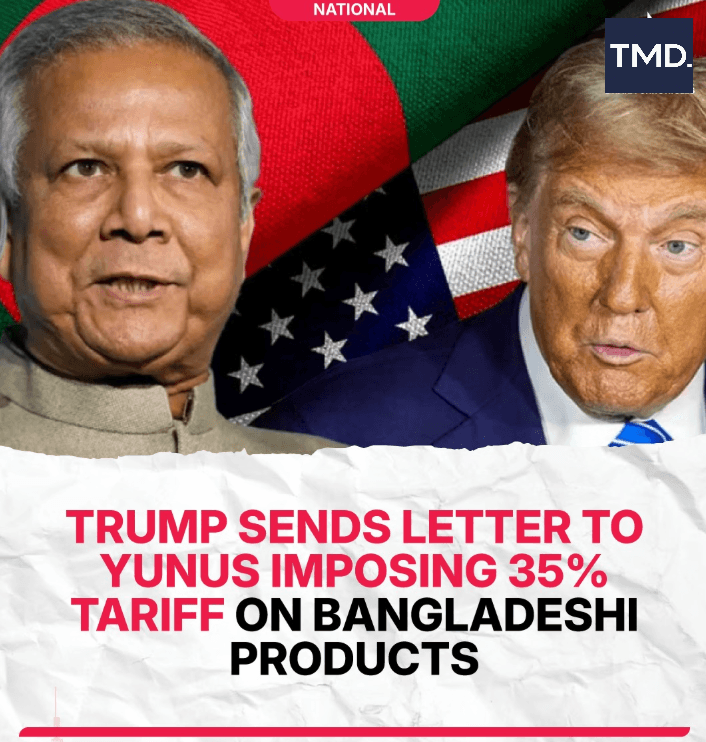BANGLADESH’S $10 BILLION NIGHTMARE? Trump’s Tariff Bomb Explodes, Leaving Yunus Awestruck.
This audacious move from President Donald Trump, particularly the severe 35% tariff imposed on Bangladeshi exports, has ignited critical concerns and left a nation, including its revered Nobel Laureate Muhammad Yunus, reportedly in “total shock.” President Donald Trump has unleashed a fresh and formidable wave of tariffs, impacting a staggering 14 countries, but none more acutely than Bangladesh. As Bangladesh grapples with this devastating blow, an unexpected “golden opportunity” simultaneously carves itself out for others, most notably India.
These new tariffs are the embodiment of Trump’s unwavering “reciprocal” trade policy, a core tenet of his economic philosophy that seeks to forcefully rectify what he perceives as imbalanced trade relationships where the U.S. is at a distinct disadvantage. His administration has unequivocally declared a national emergency regarding the U.S. trade deficit, vehemently asserting that a glaring lack of reciprocity in bilateral trade and wildly disparate tariff rates from trading partners pose a direct and grave threat to both national and economic security.
The tariffs are officially set to take effect from August 1, 2025. This critical date follows a 90-day temporary suspension period from the initial “Liberation Day” tariffs, which were controversially announced on April 2, 2025. This brief pause was explicitly intended to facilitate intense negotiations, a final opportunity for nations to “make a deal.” However, as the looming deadline draws perilously close, many countries are now bracing for the implementation of the higher, punitive rates outlined in Trump’s latest pronouncements.

The Unveiling: Trump’s 14-Nation Tariff Targets & Rates
The tariff letters, personally posted by President Trump on his Truth Social platform, detail the reciprocal rates that will be effective from August 1, 2025. These figures are the culmination of negotiations that, from the U.S. perspective, simply failed to yield satisfactory results. The rates vary, ostensibly reflecting “tailor-made trade plans for each and every country,” a stark reminder of the individualized pressure strategy at play.
Here’s the comprehensive breakdown of the countries and their imposed tariff rates:
Country | Tariff Rate (Effective Aug 1, 2025) |
| Myanmar | 40% |
| Laos | 40% |
| Cambodia | 36% |
| Thailand | 36% |
| Bangladesh | 35% |
| Serbia | 35% |
| Indonesia | 32% |
| South Africa | 30% |
| Bosnia & Herzegovina | 30% |
| Japan | 25% |
| South Korea | 25% |
| Kazakhstan | 25% |
| Malaysia | 25% |
| Tunisia | 25% |

It’s crucial to understand that these are new tariffs, layered on top of any existing sectoral tariffs (like those on steel and aluminum) that individual countries might already face. They also follow an initial 10% baseline tariff on nearly all imports that was introduced on April 2, 2025, which Trump famously dubbed “Liberation Day.” While some nations saw their initial April rates slightly adjusted during the suspension period, these new percentages represent the definitive rates set for August 1st if no successful trade deals are finalized.
Bangladesh on the Brink: The Catastrophic 45% Tariff Blow
At the epicenter of this latest trade skirmish is Bangladesh, a nation acutely reliant on its vital Ready-Made Garment (RMG) sector. Trump’s directive has slammed Bangladesh with a staggering 35% new tariff, piled on top of its pre-existing 10% duty. This escalates the total tariff burden on Bangladeshi exports to the U.S. to an astronomical 45%. This is nothing short of a monumental, potentially catastrophic blow for a country where textiles account for approximately 80% of its total export earnings, with the U.S. historically being one of the largest and most crucial destinations for these goods.
The immediate implications for Bangladesh are projected to be severe. The drastically increased cost of exporting to the lucrative U.S. market will render Bangladeshi products significantly less competitive. This is expected to trigger a sharp and rapid decline in export volumes, threatening widespread job losses in an industry that employs millions, a significant portion of whom are women, often serving as the primary breadwinners for their families. Beyond the direct hit to garment factories, ancillary industries like packaging, logistics, and even local small businesses across the nation are bracing to feel the severe economic pinch.
Bangladesh’s economic vulnerability is further exacerbated by its relatively limited economic diversification and smaller financial reserves compared to larger, more resilient economies. Unlike certain countries that have successfully navigated and negotiated more favorable terms with the U.S., Bangladesh has continually struggled to regain its U.S. Generalized System of Preferences (GSP) status, which was unfortunately suspended in 2013 due primarily to persistent labor rights concerns.
This historical context significantly weakens Dhaka’s current bargaining position, as the U.S. remains adamant on demands for full compliance with international labor reforms before any GSP reinstatement is even considered. While Bangladesh has reportedly offered various concessions, including commitments to increase imports of U.S. agricultural products and even purchases of Boeing aircraft, these offers have seemingly fallen short of Washington’s overarching demands for broader, reciprocal market access.
The Bangladeshi government is engaged in intense, last-ditch diplomatic efforts with U.S. trade authorities, desperately hoping to explore any possibilities for preferential treatment or at least a more gradual implementation of these devastating tariffs. However, the precedent set by other nations, such as Vietnam, which successfully secured a lower 20% tariff by offering substantial zero-tariff access for specific U.S. products, suggests that Bangladesh faces an incredibly uphill battle in securing a truly reciprocal and beneficial deal.
The current predicament starkly underscores the urgent and critical need for Bangladesh to aggressively accelerate its economic diversification efforts and strategically seek new, robust export markets to drastically reduce its over-reliance on the RMG sector and the U.S. market.
India’s Unprecedented “Golden Opportunity” Amidst the Turmoil

In striking contrast to Bangladesh’s precarious situation, India stands poised to gain significantly, potentially enjoying an unprecedented advantage from these new U.S. tariff measures. This situation presents a veritable “golden opportunity” for Indian textile manufacturing companies that possess a primary focus on exports. The crucial context for this unexpected opportunity lies in Donald Trump’s consistently expressed interest in forging a comprehensive and robust trade deal with India. Recent reports from high-level negotiations indicate that the U.S. and India are “close to making a deal,” with ongoing discussions intensely focused on finalizing an initial, limited bilateral trade agreement.
This eagerly anticipated potential trade deal could unlock billions of dollars in market access for Indian companies into the colossal American market. This is a strategic space that was previously dominated by Bangladeshi and other Southeast Asian exporters, who are now facing the daunting prospect of significantly steeper tariffs. Indian negotiators have reportedly put forth substantial offers of market access to a broad range of U.S. products across most sectors, with a tactical focus on initially excluding highly sensitive areas like dairy and agriculture to facilitate a quicker agreement.
In return, the U.S. is widely expected to offer considerably lower tariffs on labor-intensive sectors, which include textiles and footwear – a move that would directly and massively benefit India’s robust manufacturing base.The existing scenario where Indian textile firms faced a considerable 26% tariff when exporting to the U.S. could witness a dramatic reduction, potentially plummeting to as low as 10% under a newly inked agreement. Such a reduction would be an absolute game-changer for major Indian textile companies with substantial exposure to the U.S. market. While formidable competition from established players like China and Vietnam persists, this newfound relative tariff advantage could significantly boost India’s competitiveness and market share.
Furthermore, India has been proactively working to enhance its textile export capabilities, with ambitious initiatives aimed at surging textile exports to an impressive $100 billion by 2030-31. The current geopolitical shifts, directly driven by Trump’s assertive tariff policy, could provide an unexpected and powerful tailwind to these national ambitions, allowing India to integrate much more deeply into global value chains and potentially capitalize on the void left by other severely affected nations. However, it’s worth noting that the Indian government has consistently maintained its stance that it prioritizes national interest over strict deadlines in trade negotiations, even as the critical August 1 deadline approaches.

Trump’s Calculated Strategy: Pressure for Bilateral Deals
These tariffs are explicitly being imposed on countries with whom Trump does not currently foresee a comprehensive and mutually beneficial trade deal. His overarching strategy appears to be one of relentless, aggressive bilateral negotiation, masterfully leveraging the formidable threat of crippling high tariffs to extract significant concessions and highly favorable trade terms from individual nations. He has granted these countries a limited window, until August 1, 2025, to engage in negotiations and present compelling counter-offers or concessions that could potentially allow them to avoid or at least significantly reduce the imposed tariffs.
This unilateral approach, while proving effective in certain instances, has also drawn sharp criticism for its tendency to fragment regional unity among economic blocs like ASEAN and for its perceived undermining of established multilateral trade frameworks. Countries now find themselves in an unenviable position where they must make potentially costly economic concessions to their sovereign interests to avoid even harsher punitive penalties.
For many of these export-reliant economies, the agonizing decision to either engage in intense negotiation or simply face the full brunt of the tariffs is a profoundly difficult one. The economic fallout from these tariffs could be substantial, potentially leading to an increase in consumer prices, a significant contraction in GDP growth, and a worrying surge in unemployment rates. However, Trump’s well-documented history of “chickening out” or making abrupt U-turns on tariff decisions introduces a significant layer of uncertainty into the long-term impact of these measures.
While the August 1 deadline is presented as unequivocally firm, Trump himself has subtly indicated a degree of flexibility should countries present truly compelling alternative offers, famously stating that the deadline is “firm but not 100 percent firm.”
The Turbulent Horizon: Navigating Global Trade’s Unpredictable Future
The current tariff regime under Donald Trump is unequivocally creating a highly volatile and intensely unpredictable environment for the future of global trade. While some countries, notably Vietnam and the UK, have managed to secure relatively better deals, the economic cost of such appeasement can be substantial and, crucially, may not guarantee long-term stability or immunity from future trade disputes. It is also pertinent to note that the legal basis for these “reciprocal tariffs” has been actively challenged in the U.S. Court of International Trade, with some preliminary rulings going against the administration. Although appeals are ongoing, this legal uncertainty further adds to the complexity surrounding the longevity and enforceability of these sweeping measures.
For Bangladesh, the path forward is undoubtedly challenging but remains clear: pursue persistent and astute diplomatic efforts, aggressively diversify its export markets beyond its traditional reliance, and continue with vital domestic reforms, particularly in the realm of labor rights, to significantly improve its overall trade standing on the global stage. For India, the opportunity presented is undeniably ripe for the taking. However, capitalizing on it will necessitate extremely strategic and deft negotiations to secure a genuinely beneficial trade deal that maximizes market access for its key sectors while simultaneously robustly protecting its own sensitive domestic industries.
The broader implications for the global economy are also profoundly significant. The proliferation of increased tariffs directly contributes to higher prices for consumers worldwide, the very real potential for severe disruptions in intricate global supply chains, and a pervasive atmosphere of profound trade uncertainty. As nations bravely navigate these turbulent and uncharted waters, the long-term impact on economic growth, employment rates, and the delicate fabric of international relations will be closely and anxiously watched.
The coming weeks and months, leading up to and beyond the pivotal August 1 deadline, will be crucial in determining the immediate fallout and the fundamental direction of global trade for years, if not decades, to come. Furthermore, Trump’s recent warning of an additional 10% tariff on BRICS countries “aligning themselves with Anti-American policies” adds yet another dimension of complexity and potential tariffs, regardless of previous deals, powerfully underscoring his “loyalty trumps legality” approach to international trade.

